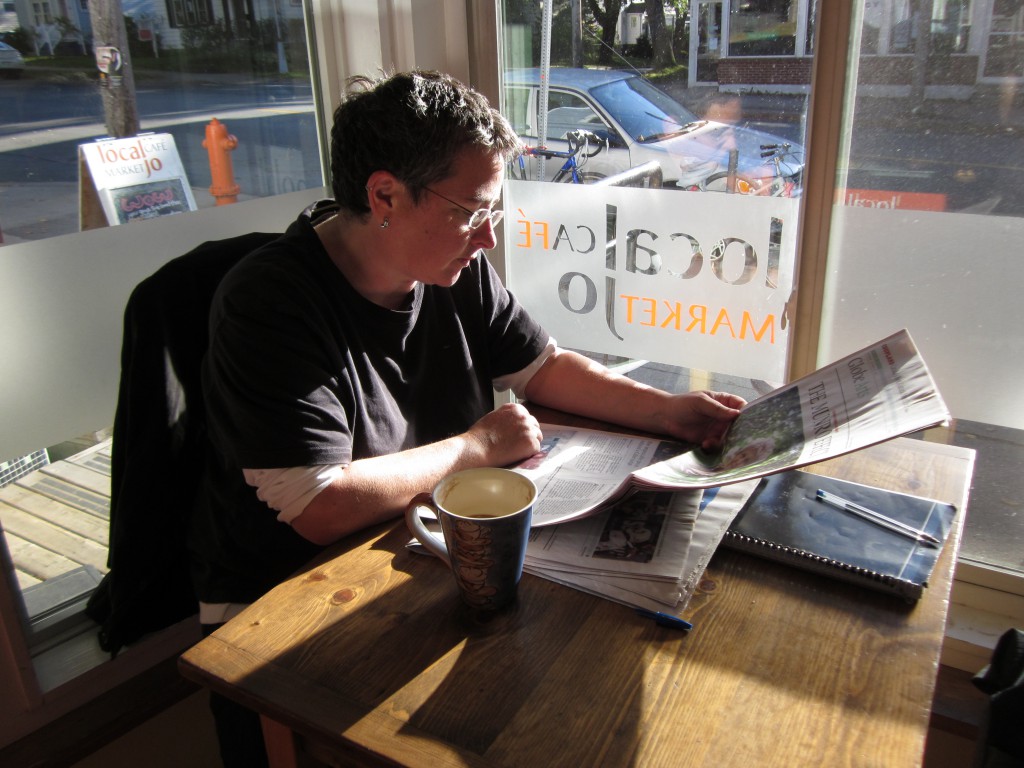Female journalists defy Hollywood stereotype

caption
Chronicle Herald columnist Angela Mombourquette still feels the “boys’ club” effect at work.Movies, TV persist with the glamorous, the villain and the fool
Halina St. James woke up on the 18th floor of her hotel room in Kuwait. The weather was not, as one would expect, warm and sunny. It was freezing. Outside, the sky was murky from burning tar and bomb smoke. Her breakfast: peanut butter straight from the jar, scooped up with her fingers.
Later that day she would go to the Hilton, where journalists from NBC had set up offices. The hotel’s pools, once clean and blue, now reeked of urine. Around the pools, abandoned hotel rooms were left open. Realizing she had to pee, St. James entered the first one. The toilet she found overflowed with feces, but she had no time to search for something cleaner. There, in the midst of the first Gulf War in 1990, St. James followed one of her cardinal rules. If there’s a toilet, pee.
A former CBC national news reporter and producer, St. James has stories screenwriters dream of. But that doesn’t mean she’ll be on the big screen anytime soon.
If St. James’ story were filmed, she would probably have to fit a journalist stereotype: tough and witty, naive and overly sentimental, an alcoholic, or morally corrupt. A 2011 report by Martha Lauzen, director of the San Diego State University Center for the Study of Women in Television and Film, states that in Hollywood only one out of nine movies casts women as heroes. While the on-screen image gets many things right – like the fact women still have to choose between work and family – the rest of the cliché is unhealthy baggage. Without a balance between drama and accuracy, the public ends up with a skewed perception of women in the media.
Wicked Women Write Well
For every movie about a clever and ethical Jane Craig (Broadcast News), there’s a ruthless Miranda Priestly (The Devil Wears Prada) and an ambitious Zoe Barnes (House of Cards). Film and TV love wicked women journalists.
Why do these roles keep showing up? Tara Thorne, CBC Radio Halifax film critic, has a simple answer: the truth is “not sexy.” Playing by the rules can be boring. It’s hard to make tweeting look exciting, unless it creates drama. (For the record, Thorne’s favourite fictional journalist is Murphy Brown, because she “had integrity.”)

caption
Film critic Tara Thorne with her Murphy Brown DVD.“No one’s writing good journalism movies,” says Thorne. “And no one’s writing good women. Hardly ever.”
Even iconic Lois Lane, a Pulitzer Prize-winning journalist, is best known as Superman’s girlfriend.
Janice Landry, former Halifax CTV reporter, now a mother and freelancer, finds film portrayals of journalists incomplete. “I don’t think they accurately portray the amount of work and dedication it truly takes to work in this field,” says Landry. While she now works five to six hours a day on writing and interviewing, the only time Sex and the City’s Carrie Bradshaw ever worked on film was when she was typing away at her computer, “I couldn’t help but wonder…”
Angela Mombourquette can’t help but wonder how Bradshaw sustains her relationship with her best friends when she divulges their romantic adventures in her column every week. Mombourquette, a freelancer and associate editor of Saltscapes magazine, writes a weekly column for the Chronicle Herald. She says she’s comfortable drawing from her personal life for her column, but stops short at “crossing other people’s lives.”
In the film Thank You For Smoking, journalist Heather Holloway publishes an exposé on tobacco lobbyist Nick Naylor. The article is far from flattering, and littered with private information Holloway got while the two had sex. “There’s a lot of information in here that was off the record,” Nick complains. Holloway replies mockingly, “You never said anything about off the record.”
Scenes like this depict female journalists as sultry serpents not to be trusted.
Movies with terrible female journalists continue to sell. Dalhousie University films studies professor Dr. Shannon Brownlee says it’s because women-centric films in Hollywood are such a minority. “I’ve listened to news programs where women phoned in and said (about the Sex and the City movie), ‘it was a crappy movie’,” she says. “’I went to see it because finally there were women on screen. You know, it was about women and I’ll take a second- or even third-rate representation of women over no representation at all.”
Sob sisters
Journalism historian Howard Good of SUNY New Palz in New York writes in his book Girl Reporter that onscreen women reporters have entertained audiences since the 1920s. They were perfect because they served dual roles: on one hand, they were feisty stunt girls who did wild things that everyday women couldn’t do, like go undercover for a scoop. On the other, they were “sob sisters” – characters who provided emotional appeal by acting sweet and sympathetic towards others. By the end of the film, stunt girls and sob sisters often left journalism to get married. Audiences loved it.
Joe Saltzman of the University of Southern California remarks in Sob Sisters, an essay published on the Image of the Journalist in Popular Culture database, that women viewers “loved the way the woman gave it to the man throughout the film, but they didn’t trust any woman who didn’t put family and children above a career.”
The onscreen habit of women reporters in the 1930s giving up work for love was actually fairly accurate. Howard Good writes, “[Women] were often fired when they became pregnant. Elsie Carper of the Washington Post recalled that the day a woman even mentioned she was getting married she was, in effect, resigning from newspaper work.”
It’s not really about how you look, it’s about what you’re sharing with people.Maria Panopalis, CTV News at 5 anchor
Angela Mombourquette has been working in media since the ‘80s, back when it was a “real boys’ club.”
“I’ve had some very good women bosses and some good male bosses as well,” she says.
Mombourquette says some older male bosses express more concern about a male co-worker’s workload than her workload. Mombourquette doesn’t blame them for this – “it’s almost subconscious,” she says. “They just have a perception that men work harder, or that men’s work is more valuable. I don’t know what they base that on. I guess because it’s a reflection of how they work or how they see themselves, maybe.”
Stories that matter
A survey taken between 2002 and 2005 by Marsha Barber and Ann Rauhala, two professors at Ryerson University, suggested a similar gap—of 221 news editors and directors in Canadian media, only 19 per cent were women.
In the same article, written in 2008, the authors discovered that while women weren’t being confined to writing women’s issues, many left because they couldn’t report stories that mattered. Some female journalists even believed that to be successful they shouldn’t have families.
Old news values still exist. And with it, the perception of beauty.
There’s an ongoing gag in pop culture that news anchors are obsessed with looking good. Suzanne Stone (To Die For), speaks of beauty as though it’s a gateway to fame. There’s a practical reason for looking presentable – viewers can get distracted – but Maria Panopalis says real journalists won’t spend more than 15 minutes in the makeup room.
“It’s not really about how you look, it’s about what you’re sharing with people,” says Panopalis, CTV’s News at 5 anchor and co-producer.
At her desk, Panapolis wears a sweatshirt over her work clothes. She wants to be comfortable, because when she’s not out interviewing or shooting footage, Panopalis works from 9:15 a.m to 4 p.m to coordinate the show. It’s hectic, but she does it because she loves it.
“I’m curious about what’s happening in my community and the world,” says Panopalis. “So why not do that all day – why not consume information and share it with people in a way that’s understandable to them?”
Unlike Suzanne Stone, Panapolis wasn’t looking for fame. Neither was Halina St. James, whose work included covering the 1989 Romanian revolution, busy election campaigns, and two Olympic Games. She laughed when asked if she thought her work was glamourous.
“Bullshit!,” she says on the phone. “It was hard.”
Work, especially when it involved travel, often meant standing in a hotel lobby. There was never any time for sightseeing, certainly not for eating well either. When she and her team covered the Romanian revolution, they found themselves as hungry as the local people. “There was no food,” she explains. They had to ask soldiers for gas to fuel their car.
To this day, St. James isn’t sure how she dealt with the stress of danger and deadlines. In HBO’s The Newsroom fictional reporter Maggie Jordan drinks to cope with her traumatic experience in Africa. But real journalists can’t afford to be drunk on the job. St. James meditated and took vitamins daily. She followed two more rules at work. No alcohol. And no sex.
“You get a lot of offers on the road,” she says wryly. “I only broke that rule once.”
She’s married to him now.
Vain, villainous and naive—these shallow imaginings of women journalists leave a lot to be desired. In reality, female journalists are more complex than their Hollywood counterparts.
St. James and other journalists show women can hold their own as compelling heroines. They are busy challenging the female journalist archetype that pop culture has created.

